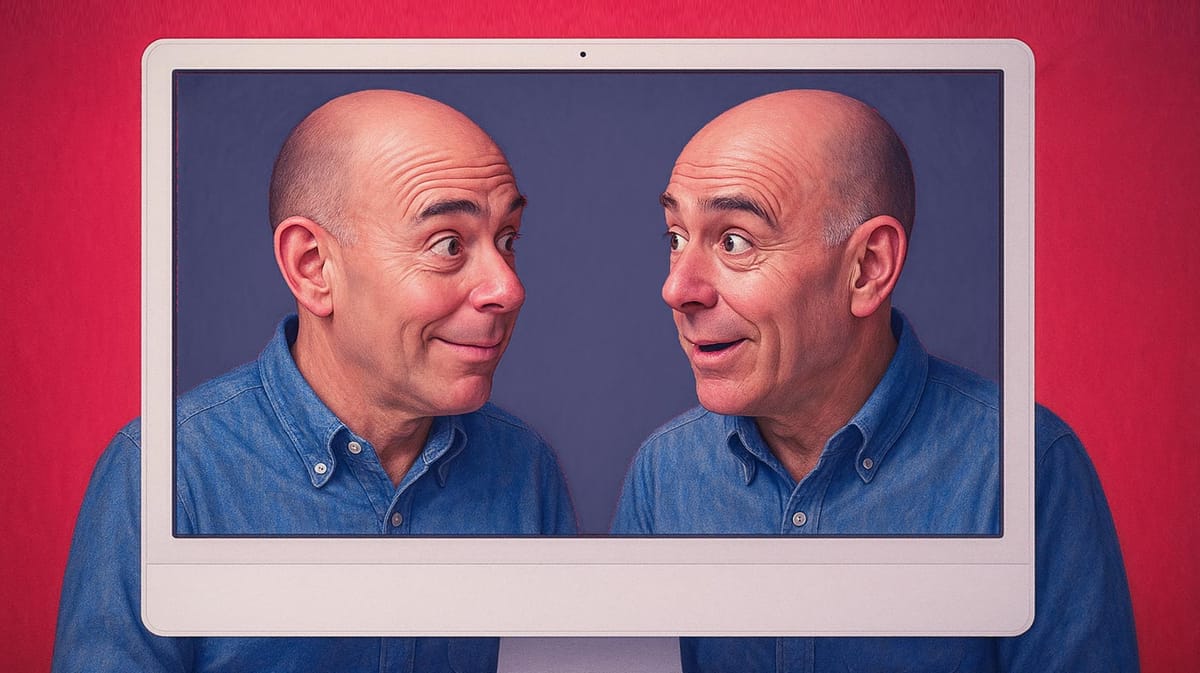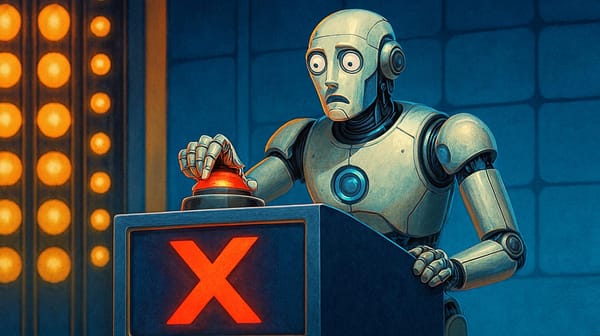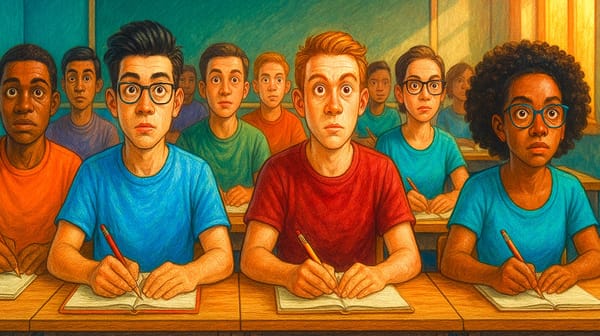Are AI Avatar Videos Finally Ready for Prime Time?
I really want them to be. Here's my honest opinion...

I’ve been hearing whispers lately—podcast chatter, LinkedIn posts, the usual “this changes everything” headlines—claiming that AI video avatars and digital clones have taken a massive leap forward. And I'd been writing it off. My hype sensor tingling. But curiosity began to get the better of me with talk of flawless lip sync, realistic expressions, and impressive voice cloning. So, as the whisper got louder, I began to really wonder if I could create convincing digital doppelgangers.
I produce a lot of client videos featuring subject matter experts—“talking head” content that must be polished, authoritative, and trustworthy. Scheduling interviews, managing lighting, optimizing audio, and editing the final product eats up hours. Even with AI tools that promise to automagically generate perfect clips, there's always something that needs a tweak. That's the reality. So, the lure of a digital clone? It's mighty tempting. Just feed it a script, and voilà ... video done.
Naturally, this raises a few pressing questions: Are these avatars and clones truly advanced enough that viewers can’t tell they’re not real? If they do look off, do we even care? If they’re 99% believable, will that final 1% be all anyone notices?
Those questions led me to examine multiple AI avatar providers—Synthesia, HeyGen, D-ID, Lemon Slice, and more. A quick Google search yielded endless YouTube reviews and blog posts raving about how “incredible” each one is. But I’m not here to publish another affiliate-laden list. I wanted to find the single most convincing avatar tool and scrutinize it from a marketer’s perspective.
The Sordid Past
AI avatar technology owes its origins to deepfakes—those face-swapping videos that began raising eyebrows around 2017. The same tricks that could superimpose famous faces in fabricated scenes also laid the groundwork for “synthetic media.” Companies like Synthesia and HeyGen soon emerged, offering lifelike avatars for more respectable use cases. Think marketing, e-learning, and more. Their promise? That you’d never need to step in front of a camera again.
The Present Need
Right now, my workflow looks like this: record an interview with an SME via Riverside.fm, edit out flubs, add captions, and produce short clips for social media. Even with AI-based editing, the process is still time-intensive (especially when taking client edits into consideration). So I went hunting for an AI avatar tool that could truly preserve the authenticity of a real person—while chopping the grunt work in half. After reading a slew of reviews and watching countless demos, I landed on HeyGen as the most realistic, advanced option. It was the top contender in a field brimming with so-so alternatives.
There's no shortage of "reviewers" gushing about AI video avatars and digital clones. But if you dig deeper, you’ll also find forum posts complaining about awkward mouth movements or stiff body language. In other words, the hype machine is running full speed, yet many real users aren’t as convinced. The uncanny valley is alive and well. And clients are understandably skittish about being “digitally cloned” if the result is anything less than flawless. I put myself in that category as well. It's less about trying to fool an audience, more about not creeping them out.
My Honest HeyGen Review
Keep in mind, I'm tackling a very specific goal: replacing the on-camera “talking head” for subject matter experts in a way that doesn’t feel like a gimmick. Even though HeyGen (and similar platforms) cater to multiple business use cases, my success criteria come down to realism and trust. If an avatar slips even a bit into the uncanny, it risks eroding the credibility of the expertise being delivered. IMHO, that's a huge liability for marketing content.
For my test, I recorded a two-minute video of myself—gestures, verbal nuances, all of it—which HeyGen uses for “training data.” Then I uploaded a separate audio clip so HeyGen could capture my actual voice rather than generating a synthetic one from text. Overall, the user experience was seamless and intuitive. Straightforward interface, quick rendering, hardly any fiddling required. All good so far.
Then came the final output. And my mixed reaction. A three-part response that's beginning to feel commonplace with every AI tool I evaluate:
Wow, this is utterly amazing.
But not good enough.
Yet.
See for yourself below. It’s not difficult to spot the issues. Some of them are on me. A few bizarre gestures and a monotone delivery, for example (I'm not exactly oozing with on-camera charisma). Next time, I’ll keep my expressions calmer and muster a good bit more vocal inflection. But most of us think we look and sound weird on camera anyway. I was expecting that. I was looking for that hard-to-put-your-finger-on quality that just said, "My clients will never go for this."
My digital clone, created with HeyGen: Take One
And I saw it. The subtle disconnect between the spoken words and the facial expressions. The repetitive movements. And the eyes. The eyes never lie. Man, it’s getting close. It’s even there for other use cases as I’ll mention below, but to ask a CEO or SME to hand their digital clone over to the marketing team based on this? Most have hangups about ghost writing … and this takes it to a whole new level.
Still, none of this deters me from continuing to experiment. With more practice and better input material (not to mention a paid upgrade), I suspect I’ll coax better results out of HeyGen. The tool already hints at a future where a polished, on-brand digital twin can cut production time drastically. But for now, my clone remains in R&D. If I’m going to put a CEO or SME’s likeness in front of an audience, it needs to reach a standard where even that lingering 1% of “something’s off” never crosses the viewer’s mind.
All of that said, I do think HeyGen is a viable (and wildly cost-effective) tool for certain use cases right now. Here's my take on what's ready for prime time and what's not...
What’s Ready for Prime Time:
- Internal Training & Onboarding: Where novelty can boost engagement, and slight imperfections aren’t a deal-breaker.
- Basic Explainer Videos: Simple scripts and short durations reduce the odds of uncanny distractions.
- Non-Human Avatars: Animated mascots or stylized characters sidestep the “fake human” problem entirely, as they don’t try to appear real.
What’s Not:
- High-End Brand Campaigns: Premium brands risk a backlash if their digital “spokesperson” feels untrustworthy.
- Influencer & Executive-Facing Content: Authenticity is crucial in building credibility, and a synthetic face can tank that trust in seconds.
- Client-Facing Work Where Realism Is Key: If you need genuine personal connection, any hint of “robotic expression” can derail the entire message.
While HeyGen and similar tools are impressive, they spotlight a broader issue: marketers and brand leaders must vet AI advances with a dose of healthy skepticism. AI avatars are a prime example of tech hype running ahead of genuine readiness for high-stakes marketing. The next year or two may bring breakthroughs in micro-expressions and emotional range that push AI avatars to new levels. Until then, use them cautiously or risk damaging your brand’s credibility. In my opinion.
Reality Check
AI video avatars—HeyGen chief among them—are fascinating. They’ve come a long way, but there’s still ground to cover before they seamlessly replace real human presenters in high-stakes marketing. For me, the promise of reducing video production headaches remains tantalizing but unfulfilled. If the end product doesn’t pass a human sniff test, it’s just not worth the potential fallout.
Still, I truly believe AI avatars and digital clones are the future, and I’ll be watching closely as they continue to evolve. My advice? Experiment for internal or low-risk content, but think twice before rolling out a virtual spokesperson for your clients or their social accounts. In a sea of hype, stay anchored in what actually meets your brand’s standards of authenticity and quality—because, for now, that subtle “uncanny valley” won't be doing you any favors.






